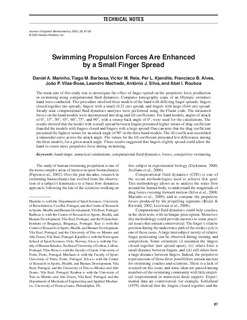| dc.contributor.author | Marinho, Daniel A. | |
| dc.contributor.author | Barbosa, Tiago | |
| dc.contributor.author | Reis, Victor M. | |
| dc.contributor.author | Kjendlie, Per-Ludvik | |
| dc.contributor.author | Alves, Francisco B. | |
| dc.contributor.author | Vilas-Boas, João P. | |
| dc.contributor.author | Machado, Leandro | |
| dc.contributor.author | Silva, António J. | |
| dc.contributor.author | Rouboa, Abel I. | |
| dc.date.accessioned | 2010-08-23T12:05:56Z | |
| dc.date.available | 2010-08-23T12:05:56Z | |
| dc.date.issued | 2010-02 | |
| dc.identifier | Seksjon for fysisk prestasjonsevne / Department of Physical Performance | |
| dc.identifier.citation | Journal of Applied Biomechanics. 2010, 26(1), 87-92 | en_US |
| dc.identifier.issn | 1065-8483 | |
| dc.identifier.uri | http://hdl.handle.net/11250/170637 | |
| dc.description.abstract | The main aim of this study was to investigate the effect of finger spread on the propulsive force production
in swimming using computational fluid dynamics. Computer tomography scans of an Olympic swimmer
hand were conducted. This procedure involved three models of the hand with differing finger spreads: fingers
closed together (no spread), fingers with a small (0.32 cm) spread, and fingers with large (0.64 cm) spread.
Steady-state computational fluid dynamics analyses were performed using the Fluent code. The measured
forces on the hand models were decomposed into drag and lift coefficients. For hand models, angles of attack
of 0°, 15°, 30°, 45°, 60°, 75°, and 90°, with a sweep back angle of 0°, were used for the calculations. The
results showed that the model with a small spread between fingers presented higher values of drag coefficient
than did the models with fingers closed and fingers with a large spread. One can note that the drag coefficient
presented the highest values for an attack angle of 90° in the three hand models. The lift coefficient resembled
a sinusoidal curve across the attack angle. The values for the lift coefficient presented few differences among
the three models, for a given attack angle. These results suggested that fingers slightly spread could allow the
hand to create more propulsive force during swimming. | en_US |
| dc.language.iso | eng | en_US |
| dc.publisher | Human Kinetics | en_US |
| dc.subject | hand shape | en_US |
| dc.subject | numerical simulations | en_US |
| dc.subject | computational fluid dynamics | en_US |
| dc.subject | forces | en_US |
| dc.subject | competitive swimming | en_US |
| dc.title | Swimming propulsion forces are enhanced by a small finger spread | en_US |
| dc.type | Journal article | en_US |
| dc.type | Peer reviewed | en_US |
| dc.subject.nsi | VDP::Social science: 200::Social science in sports: 330::Other subjects within physical education: 339 | en_US |
| dc.source.pagenumber | 87-92 | en_US |
